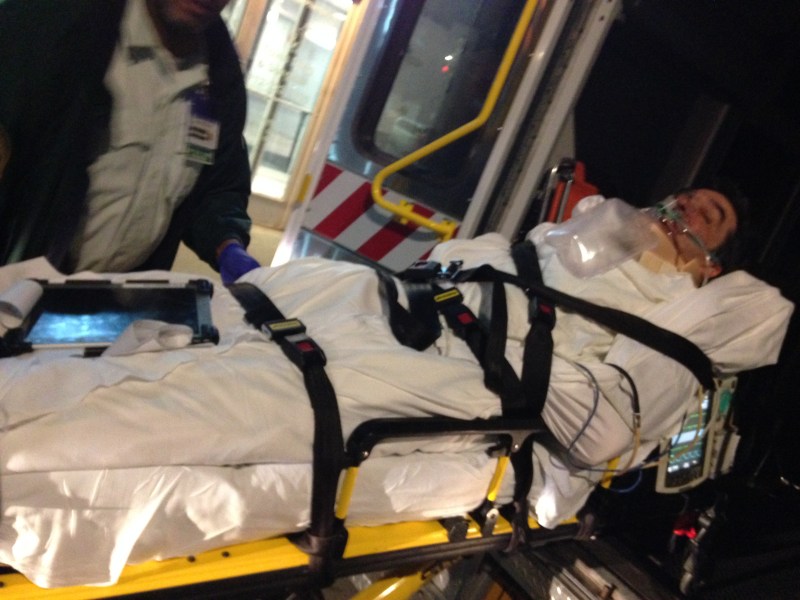Eighth Avenue’s Narrow Sidewalks Land a Cyclist in the Hospital
With six lanes for traffic and parking but only a narrow band for the much larger number of people on foot, it was only a matter of time before tensions boiled over.

Midtown sidewalks are so narrow and crowded that some avenues are constantly simmering with low-level conflict. On Eighth Avenue, pedestrians and cyclists squeeze into a miserly band of street space while motorists indulge in six lanes of traffic and parking.
Two weeks ago, the tension boiled over and landed Gregg Baker in the hospital.
On May 14 at around 4:30 p.m., Baker, 63, was biking up Eighth Avenue just north of the Port Authority Bus Terminal. A man walking toward him knocked Baker off his bike, sending him careening to the pavement and inflicting injuries that necessitated a three-day hospital stay.
The assault happened in the bike lane between 45th and 46th streets, which like most of Eighth Avenue in Midtown was overflowing with pedestrians in the late afternoon rush. No stranger to the tightrope act of navigating the narrow space allotted to biking and walking in that part of Midtown, Baker was proceeding with caution, biking slowly and ringing his bell.
“It’s kind of a zoo, you know, it’s rush hour so there’s pedestrians, cars, everything,” he said. “Pedestrians are heading south, I’m heading north, so they can mostly see me, but they don’t move. I had very little room to pass. I wasn’t going that fast either because, you know, it’s not possible. I don’t want to see anybody get hurt.”
As he made his way up the block, a man walking in the opposite direction in the bike lane stuck out his elbow, knocked Baker off his bike, and kept walking.
The impact of the fall caused serious injuries. Baker sustained a broken clavicle, two broken ribs, and a collapsed lung.
Baker says the police who arrived at the scene did not attempt to track down the man who assaulted him. They told him the shove was probably unintentional, he said, and didn’t check nearby storefronts for security footage that could have identified the perpetrator.
As much as the assailant is to blame, the allocation of space on Eighth Avenue was also a culprit. The failure to provide sufficient space for walking and biking makes conflict — intentional or otherwise — more likely.
In Midtown, the overwhelming majority of people are on foot. The ability to access Midtown via transit and walking sustains the city’s largest concentration of jobs and its biggest entertainment district. During the morning and evening rush, hundreds of thousands of people are heading to and from Midtown’s great transit hubs. And the sidewalk network is woefully insufficient for them.
On Eighth Avenue, the sidewalk is so packed during peak hours that the painted buffer between the bike lane and parked cars functions as an ad hoc walkway, as Streetfilms’ Clarence Eckerson and Streetsblog Publisher Mark Gorton documented earlier this month:
With so little room, Baker says pedestrian frustration is understandable. “Pedestrians are also kind of struggling for space there. I guess they’re angry too,” he said. “If I ring my bell, many, many times they do not move. They are looking right at me. They know I’m there, and they don’t move anyway.”
Baker has lived in the area for 20 years. “This part of town has changed,” he said. “There’s a lot more cars, a lot more people, and there’s more bicyclists.”
While the creation of the Broadway pedestrian plazas in 2009 relieved some of the worst pedestrian crowding in Midtown, much more needs to be done. The sidewalk network feeding Penn Station, in particular, is at a breaking point.
Building out wider sidewalks is a more expensive long-term undertaking than the parking-protected bike lanes, NYC DOT has added on some Midtown avenues over the past several years. But if Midtown is going to have a functional bike network it also needs wider sidewalks, as Baker’s experience shows so starkly.
DOT has experimented with a combination of sidewalk expansion and protected bike lanes, but only in fits and starts.
The block of Eighth Avenue between 42nd and 43rd has a painted sidewalk extension separated from the bike lane by heavy planters. The bike lane is protected from car traffic by plastic bollards — there is no parking lane on that side of the block.
That’s just one block out of at least dozens where foot traffic overflows. Another plan to widen eight blocks of the sidewalk on the west side of Seventh Avenue — between Times Square and Penn Station — has yet to be implemented, even though it would use low-cost materials and could be built out in a matter of days.
Until there’s a comprehensive plan and timetable for building out a network of wider sidewalks and protected bike lanes in Midtown, walking and biking will be relegated to second-class status on New York’s busiest streets.





